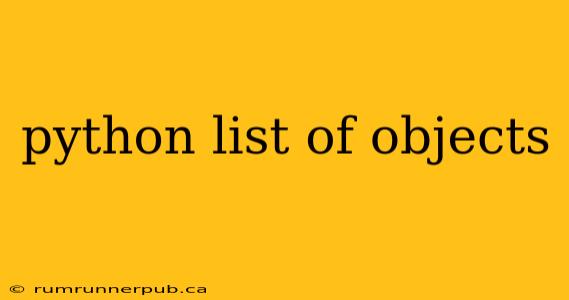Python's versatility shines when handling lists of objects. This powerful combination allows you to structure and manage complex data efficiently. This article explores common scenarios, challenges, and best practices when working with Python lists of objects, drawing insights from Stack Overflow discussions to provide practical solutions and deeper understanding.
Creating Lists of Objects
The simplest way to create a list of objects is through direct instantiation:
class Dog:
def __init__(self, name, breed):
self.name = name
self.breed = breed
dogs = [Dog("Buddy", "Golden Retriever"), Dog("Lucy", "Labrador"), Dog("Max", "German Shepherd")]
for dog in dogs:
print(f"{dog.name} is a {dog.breed}.")
This creates a list named dogs containing three Dog objects, each with its name and breed attributes.
Accessing and Modifying Object Attributes
Accessing attributes within a list of objects is straightforward:
print(dogs[0].name) # Accesses the name of the first dog in the list. Output: Buddy
dogs[1].breed = "Golden Doodle" # Modifies the breed of the second dog.
Important Note: Modifying an object within the list directly changes the object itself, not just a copy. This is a crucial concept to understand to avoid unexpected behavior.
Searching and Filtering Lists of Objects
Finding specific objects within a list often requires more than simple indexing. Let's say we want to find all Golden Retrievers:
golden_retrievers = [dog for dog in dogs if dog.breed == "Golden Retriever"]
print(golden_retrievers)
This utilizes list comprehension, a concise way to create new lists based on existing ones. This approach, as seen in numerous Stack Overflow discussions (e.g., questions related to filtering lists based on object attributes), is generally preferred for its readability and efficiency.
Sorting Lists of Objects
Sorting lists of objects necessitates defining a sorting key. Let's sort our dogs alphabetically by name:
dogs.sort(key=lambda dog: dog.name)
print([dog.name for dog in dogs]) #Prints the names in alphabetical order
The key argument in the sort() method specifies a function (here, a lambda function) that extracts the sorting criteria from each object. Understanding the key argument is vital, as highlighted in many Stack Overflow questions regarding custom object sorting.
Handling potential AttributeError
Accessing attributes of objects that might not exist can lead to AttributeError. Defensive programming is crucial:
def get_dog_info(dog):
try:
name = dog.name
breed = dog.breed
print(f"Name: {name}, Breed: {breed}")
except AttributeError:
print("Incomplete dog information.")
for dog in dogs:
get_dog_info(dog)
This example demonstrates the use of try...except blocks to gracefully handle situations where an object might lack expected attributes, a frequent topic on Stack Overflow related to error handling.
Advanced Techniques: Object Methods and List Manipulation
Often, you'll want to add functionality directly to your objects. Methods allow this:
class Dog:
# ... (previous code) ...
def bark(self):
print("Woof!")
for dog in dogs:
dog.bark()
This enhances your code's organization and readability, mirroring best practices from countless Stack Overflow answers advocating for object-oriented programming.
This article has touched on the core aspects of working with Python lists of objects. Remember to consult Stack Overflow for specific issues or advanced scenarios. By combining the power of Python lists with well-structured classes and error handling, you can efficiently manage and process complex data within your applications.
